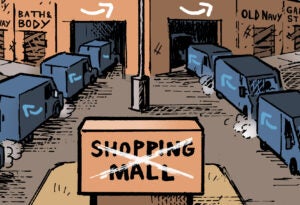The programmatic mindset often works well when applied to non-advertising industries.
Such has been the case for Crisp, the CPG and retail data analytics business founded by Are Traasdahl, who formerly founded and led Tapad through its acquisition by Telenor in 2020.
On Wednesday, Crisp announced its acquisition of Cantactix, an in-store analytics company that helps retailers optimize their shelf space.
This is Crisp’s sixth acquisition over the past year and its fourth deal in the past few months. Its spree includes Atheon Analytics (grocery store SKU-tracking), ClearBox (which extended Crisp into the food services category, including restaurants) and Shelf Engine (which optimizes how retailers order perishable goods).
How it works
Crisp thinks of retail store space as real estate, Traasdahl told AdExchanger.
The retailers themselves “want to make as much profits as possible per linear feet of shelf space,” he said. Brands, meanwhile, want to understand and optimize where they’re placed on shelves and what products are placed around them.
Cantactix is useful to Crisp because it creates planograms, which is a bit of retail industry jargon for a type of graphic that breaks down shelves into tic-tac-toe-style diagrams that make it easier to visualize where products sit in a store.
Planogram details that plot products on the shelves are critical bits of information for brands, Traasdahl said.
Many CPG or grocery brand categories aren’t necessarily growing categories. “So the only way that they can generate more profit is through conquesting and getting one of the competitors off of the shelf and their product onto the shelf.”
Crisp doesn’t facilitate those connections between retailers and brands, as in, it doesn’t recommend products to a retailer to fill shelf space nor can brands pay to gain visibility. But the product is important for brands to demonstrate to retailers that they’re driving better value than others on the same row, for instance, Traasdahl said.
The (sort of) marketing connection
Crisp has no direct marketing applications. It’s not a CDP or mar tech vendor. But it is indirectly connected to marketing.
For example, Traasdahl said, brands are pressured to prove that they’re running advertisements that drive store traffic for a retailer. Grocery brands are “always in a mode where they need to show that they’re doing advertising and marketing to support the brand [in the store], he said.
Crisp also literally overlaps with the retail media industry – like, geographically.
The company has roughly 50 people based in Bentonville, Arkansas. For those uninitiated in the brick-and-mortar retail biz, any mention of employees in “Bentonville” or Arkansas in general means those people are, essentially, an embassy to the kingdom of Walmart.
Crisp, which totals 300 employees, has another 40 people in Minneapolis, Minnesota, which is a major retail media hub as home base for Target, Best Buy and a number of major grocery brands, including General Mills, Cargill, Hormel Foods and Land O’Lakes.
The programmatic pivot
Traasdahl isn’t the first programmatic OG who flipped to a non-advertising business.
Brian O’Kelley, for example, formed a company called CMDTY for tracking physical supply chains before starting Scope3, a sustainability tracking company that has since pivoted to ad tech SaaS and verification services.
But Crisp also has a feel-good angle. Aside from its data analytics business, which it sells to some 7,000 paying manufacturer customers, Crisp is on a mission to reduce food waste, Traasdahl said. Which is a natural byproduct, so to speak, when a retailer buys and sells perishable goods more efficiently.
Would Crisp ever come all the way back around, though, and use its own data services and contacts across CPG brand salespeople and retailer execs for marketing purposes? Like to recommend a brand for a competitive shelf slot. Or to enable CPG marketers to target retailer salespeople who decide which products will be stocked. For B2B marketers, this is a commonplace tactic known as account-based marketing.
“I think there is a day where kind of these things start to come together more,” Traasdahl said of Crisp perhaps someday merging with retail media businesses, many of which are trying to grow beyond just ad tech into pricing, store inventory management and forecasting – the kind of stuff Crisp does.
However, Crisp focuses on how products get into stores and onto which specific shelves, Traasdahl said, whereas retail media and ad tech is more about a shopper’s path to purchase – as in, getting something off the shelf.
But “in a way,” he said, “it is all part of the same path to purchase.”

















